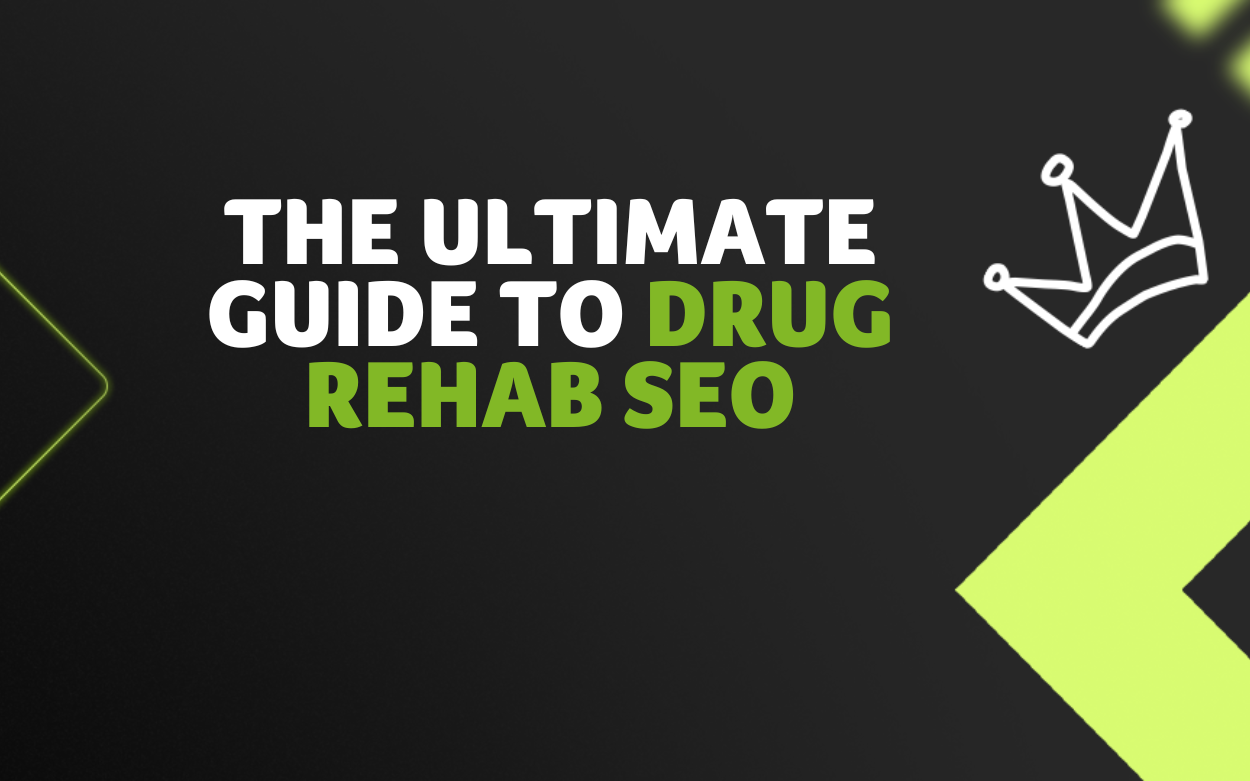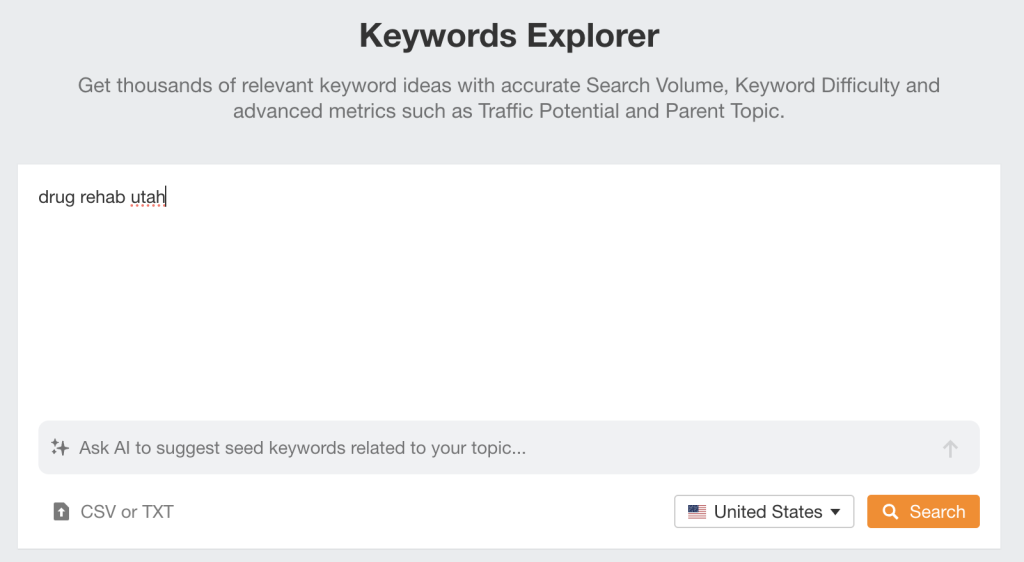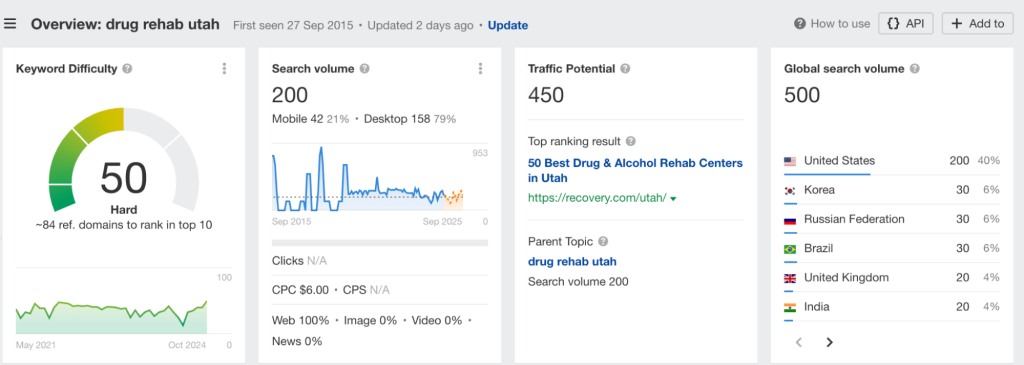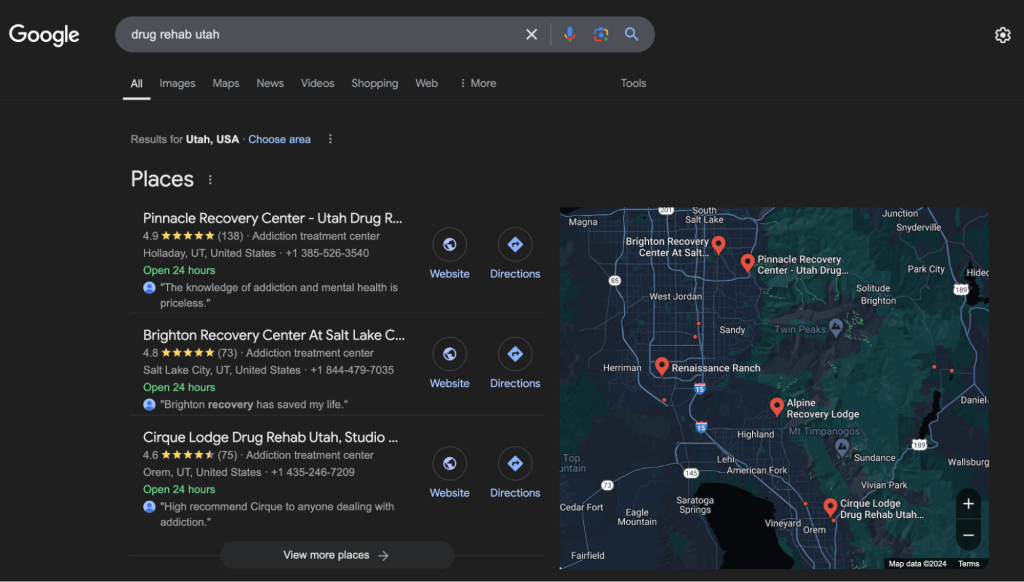
With 77% of people seeking medical services starting their search online, being easily found is crucial. It means connecting with individuals at a critical moment when they’re ready to take that first step toward recovery. This is where search engine optimization (SEO) becomes essential.
In this article, we guide you through building a drug rehab SEO strategy from the ground up. We cover optimizing your website content, building local citations, and positioning your rehab center as a trusted online resource.
These techniques can improve your search engine rankings, attract more potential clients, and ultimately help more people on their recovery journey.
What Is SEO for Addiction Treatment Centers?
As we mentioned above, SEO stands for search engine optimization. It’s the practice of improving your website and online content to ensure your website shows up higher in search results when people search for information related to your business—in this case, drug rehab services.
Why does ranking high matter?
Studies show that the top three positions on Google receive over 75% of all clicks, meaning most users never scroll down to see lower-ranked results. Websites that land on the second page get almost no traffic.
SEO is even more crucial for drug rehab centers because running ads can be difficult due to strict regulations. Without Google certification, your ability to run ads is limited, and even certified centers face restrictions on advertising.
This means that ranking organically at the top of search results is one of the most effective ways to reach potential clients. If your rehab center doesn’t rank high, it drastically limits your ability to attract new clients actively seeking help.
How does Google work?
Search engines like Google use complex algorithms to crawl and index websites, trying to understand what each website is about. Rehab SEO involves making sure these algorithms easily understand your website’s content.
For example, when someone searches for “drug rehab near me,” you want your website to be one of the first they see. Higher visibility means more potential clients will find your addiction treatment center.
The main elements of drug rehab SEO
SEO involves a multifaceted approach. Here are some of the core elements:
➡️ On-page SEO: This involves optimizing the content and structure of your website, such as the keywords, headings, images, and page speed.
➡️ Off-page SEO: This involves building your website’s authority and reputation through links from other websites, social media, and online directories.
➡️ Local SEO: This is crucial for drug rehab centers, as it optimizes your online presence to attract local clients searching for services in their area. This includes claiming your Google Business Profile and getting listed in local directories.
➡️ Content: High-quality, informative, and relevant content is the foundation of rehab SEO. This includes creating website copy, blog posts, articles, videos, and other resources that address the needs and concerns of people seeking addiction treatment.
| 💡Key point: E-E-A-T is crucial for drug rehab SEO
Google holds websites that offer advice on sensitive topics like health and finances to a higher standard. This is especially true for drug rehab centers, which fall under Google’s “Your Money or Your Life” (YMYL) category. To rank well, you need to demonstrate E-E-A-T: Experience, Expertise, Authoritativeness, and Trustworthiness.
|
➡️ Technical SEO involves optimizing your website’s technical aspects to make it easier for search engines to crawl and index your content. This includes site speed, mobile-friendliness, structured data markup, and a clear site architecture with easy navigation.
👇🏼 Confused? Don’t worry; we’ll break this all down below.
A Step-by-Step Guide to Your First Drug Rehab SEO Campaign
1. Perform Keyword Research
Keywords are the words and phrases people type into search engines. They’re the foundation of your addiction treatment SEO campaign because they tell Google what your website is about.
To get started, you’ll need to identify seed keywords—these are the core terms related to your rehab center. Think of broad terms related to your services, like:
- “drug rehab”
- “alcohol treatment”
- “addiction recovery”
- “rehab centers”
Next, you’ll need a keyword tool to do thorough keyword research. There are a few options, including SEMRush, Moz, and Ahrefs. We’ll be using Ahrefs to show you how to find keywords.
1️⃣ Go to Keywords Explorer: Enter a seed keyword like “drug rehab utah”:

Source: Ahrefs
2️⃣ Explore keyword metrics: Ahrefs will show you details for your chosen keyword, including:
- Keyword difficulty (how hard it is to rank for that keyword)
- Search volume (how many people search for it each month), and
- Traffic potential
The screenshot below shows that “drug rehab utah” has a keyword difficulty of 50, which means it’s hard to rank organically. It has a search volume of 200 and a traffic potential of 450 searches per month:

Source: Ahrefs
| 💡Key point: Why is the search volume so “low”?
You might wonder why a keyword with only 200 monthly searches is so difficult to rank for. Great question! This keyword is so competitive because it’s a high-intent keyword. A high-intent keyword refers to a search term used by people when they’re ready to take action, such as booking a service or purchasing a product. In this case, “drug rehab utah” means that people searching for this term are actively looking for a treatment center, which makes ranking for it incredibly valuable. |
3️⃣ Explore keyword ideas: Beyond your seed keywords, you’ll want to target long-tail keywords. These are longer, more specific phrases that people type when they search. Examples include:
- “inpatient drug rehab utah”
- “inpatient alcohol treatment programs”
- “drug rehab centers in utah”
Ahrefs’ Keywords Explorer provides a “Keyword ideas” report that can help you find relevant long-tail keywords:

Source: Ahrefs
| 💡Pro-tip: Think local
Include location-specific search terms. For example, “Los Angeles drug rehab” or “addiction treatment in Denver” can help you connect with people in your area who are actively searching for nearby treatment options. |
4️⃣ Check the SERP overview: See who’s currently ranking for your target keywords in Google search results. Can you create even better and more informative content?

Source: Ahrefs
5️⃣ Download and organize: Once you’ve identified your relevant keywords, export them in a spreadsheet format. Under “keyword ideas,” click on “view all.” This will take you to a detailed page with all related keywords. On the left-hand side, click “Export,” and choose to download the data in CSV format:

Source: Ahrefs
2. Set up your drug rehab local SEO
Local SEO is critical for drug rehab centers. People seeking addiction treatment often want to find services close to home. Think about it: if you were searching for “drug rehab,” you’d probably include “near me” or your city’s name.
Google understands this. When someone searches for drug rehab centers or alcohol rehab services, it displays a map with a list of local results.
But how does Google decide which centers to show? These results are influenced by several factors, including:
- Relevance: How well your website’s content matches the search query.
- Distance: How close your rehab center is to the searcher’s location.
- Prominence: How well known and reputable your addiction treatment center is (based on factors like online reviews, backlinks, and citations).
Here’s what these maps look like on search engine results pages:

Source: Google
Set up your Google Business Profile
You need a complete and optimized Google Business Profile to maximize your local visibility.
Your rehab center’s online listing will appear on Google Maps and in local search results, so it’s important to make sure to:
- Claim and verify your profile.
- Provide accurate information (address, phone number, website).
- Choose the right categories for your services.
- Upload high-quality photos of your facility.
- Encourage clients to leave reviews.
ℹ️ Here is a comprehensive guide on setting up and optimizing your Google Business Profile.
Don’t forget online directories
In addition to your Google Business Profile, list your rehab center on relevant online directories. This helps increase your rehab center’s online presence and build citations (mentions of your business name, address, and phone number), which is essential for local SEO.
Consider both general directories like Yelp and TrustPilot, as well as directories specific to the drug rehab industry, such as:
By optimizing your local SEO, you can ensure that individuals in your community can easily find your rehab center in local searches.
3. Create valuable content
Content is crucial in drug rehab SEO, especially when you’re looking to rank highly for keywords and keep your site fresh.
Regularly producing high-quality content helps search engines index your site quicker, ensuring your pages are recognized and ranked faster.
By targeting noncommercial queries—such as questions about addiction, treatment options, or the side effects of medications—you can rank for a wide range of keywords that potential clients are searching for.
| 💡Key point: What are noncommercial queries? This type of query is a search term people use when seeking information—i.e., they’re not looking to make a purchase or use a service. These are often questions or general research topics, like:
While these searches don’t mean someone’s ready for treatment, ranking well for them positions your site as a trusted resource. This can lead to future conversions when the user is ready to seek help. |
But what does good content look like?
It should be valuable to readers, answering their questions thoroughly and providing clear, helpful information.
Content should also be professionally produced, as well-written content is trustworthy and easy to read. Importantly, it should also be keyword-rich and naturally incorporate relevant terms that align with what your target audience is searching for.
ℹ️ For example, the article “Gabapentin Side Effects and High” from Synergy Sobriety Solutions covers an important topic in addiction treatment, thoroughly answering common concerns while naturally incorporating keywords. This content helps establish authority in the rehab space and attracts readers seeking specific information.
| 💡Pro-tip: It’s a great idea to create content aimed at the family and friends of those struggling with addiction.
They often seek information or treatment options on behalf of their loved ones, so providing content that speaks to their concerns can be incredibly valuable for your site’s visibility and your center’s outreach. |
4. Improve on-page SEO
On-page SEO is optimizing individual pages on your rehabilitation center’s website to rank higher and earn more relevant traffic from search engines.
To improve on-page SEO, start by ensuring that your website’s content is high-quality, relevant, and naturally includes the right keywords, as discussed in the section above.
But it doesn’t stop there—several other key elements of your web pages need to be optimized to help search engines understand what your page is about and boost your rankings.
Here’s how to improve on-page SEO:
- Optimize title tags: These act as headlines for your pages in search results. Use a clear, keyword-rich title that reflects the content of your page. It should be concise (50-60 characters) and engaging to attract clicks.
- Craft compelling meta descriptions: These short summaries appear under your title tag in search results. Write informative meta descriptions that include keywords. These should summarize your page’s content in 150-160 characters and encourage users to click through.
- Use headings strategically: Organize your content with headings (H1, H2, etc.) to improve readability and help search engines understand your page structure.
- Optimize images: Use descriptive file names and alt text (alternative text that describes the image) for your images. This helps search engines understand your images and improves accessibility.
5. Build high-quality backlinks
Backlinks, also known as inbound links, are links from other websites that point to your site. They are crucial in drug rehab SEO because search engines view backlinks as a signal of authority and trust.
The more high-quality, relevant backlinks you have, the more credible your site appears to search engines, which can lead to higher search engine rankings.
For drug rehab centers, building backlinks is essential to establish authority in your niche and reach more people seeking treatment. Below are some techniques that are especially suited for drug rehab clinics:
1️⃣ Linkable content
The best way to obtain high-quality backlinks is to create valuable, informative content that other websites want to link to. This could be articles, guides, or infographics that provide high-quality, authoritative information.
Focus on creating content that answers common questions or addresses important topics in addiction recovery. This content might attract links from health blogs, addiction websites, and medical organizations.
ℹ️ Example: According to Ahrefs, the article “Signs of a Damaged Liver” from Illinois Recovery Center has gained 719 referring domains due to its informative, link-worthy content. This content helps boost a site’s credibility while attracting relevant organic traffic.
2️⃣ Digital PR / press links
Digital PR involves securing media coverage and backlinks through online press releases, interviews, or news stories. A digital PR campaign can boost the visibility of your drug rehab center while earning high-authority links from reputable sources.
Contact local or national media outlets with newsworthy information about your clinic, such as new services or successful recovery stories. If possible, partner with a PR professional to help craft compelling stories.
3️⃣ Guest posting
Guest posting is writing articles for other websites in exchange for a backlink to your site. This helps build authority while reaching a new audience.
The best way to find opportunities is to identify relevant websites or blogs that accept guest posts, particularly in the health and wellness niche. Offer to write high-quality content that benefits their readers and includes a natural link back to your website.
ℹ️ Example: This article “What Are the Goals of a Drug Rehab Center?” on Longevity Live links back to Latana Recovery, offering helpful information while boosting the clinic’s backlink profile.
| 👑 Building online authority for your rehab facility is difficult. Let Authority Builders handle the heavy lifting with our proven link-building strategies. Get started today! |
6. Boost your technical SEO
Technical SEO focuses on optimizing your website’s behind-the-scenes elements, ensuring that search engines can easily crawl, index, and rank your pages.
While content and backlinks are essential, technical SEO ensures your drug rehab center’s site functions smoothly and is accessible to search engines and potential clients seeking rehab services.
Technical SEO covers many aspects, but let’s focus on the most important ones for drug rehab centers:
Site speed
A fast-loading site is critical, especially when someone is urgently seeking help. Ensure your images are compressed, your code is optimized, and your hosting provider ensures fast loading times to provide users with a seamless experience.
➡️ Google’s PageSpeed Insights can analyze your website’s speed and provide recommendations for improvement.
Mobile-friendliness
Most people search for treatment options on their phones, often during moments of need. Ensure your site is mobile-friendly with a responsive design so it looks and functions well on all devices.
➡️ Use Google Lighthouse to help you check whether your website is mobile-friendly.
Security (HTTPS)
Security is especially important in the sensitive field of addiction treatment. Ensure your website uses HTTPS, which protects user data and signals to search engines that your site is safe and trustworthy.
➡️ Here is a guide on implementing HTTPS encryption on your website.
Final Thoughts: Drug Rehab SEO
When someone is struggling with addiction, finding the right help quickly is crucial. Effective SEO ensures your rehab center appears at the top of search results, connecting those in need with your vital services.
Need drug rehab SEO experts?
Authority Builders specializes in helping addiction treatment centers like yours thrive online. Our services include:
Ready to increase your online visibility and help more people find their path to recovery? Sign up today!
